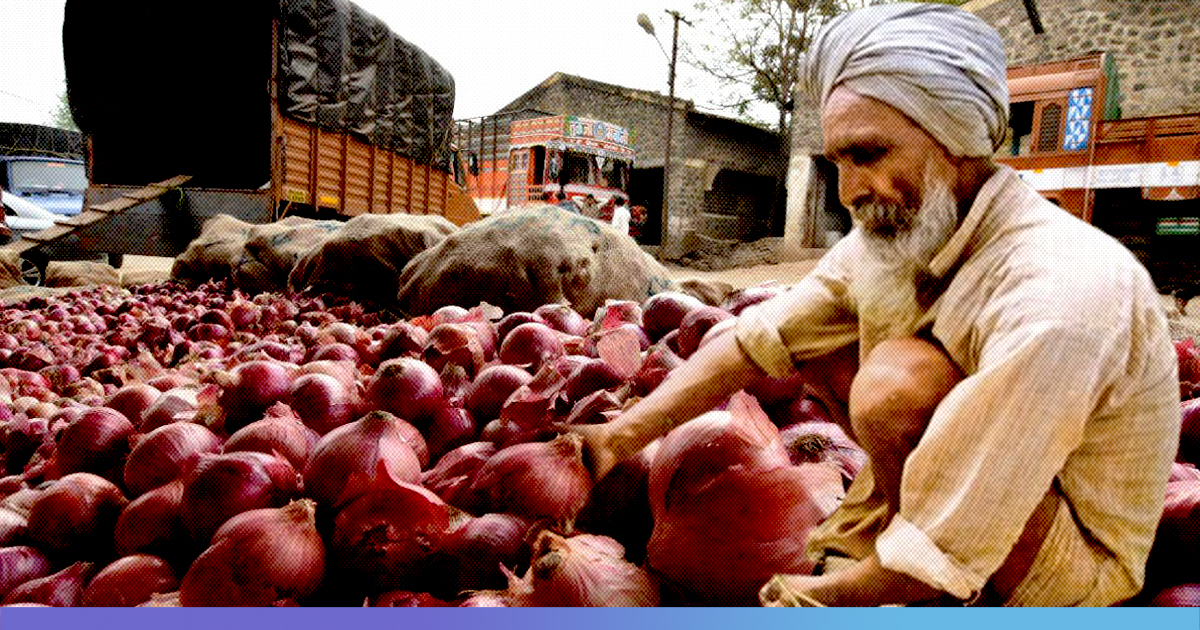In the last four days, reports of onion stolen, worth lakhs, have surfaced. In Bihar, a wholesaler has alleged theft of onion worth Rs 8.2 lakh from his storage facility located near Sonaru village, whereas all the way down to the east, a farmer from Nashik has complained that his stock onions worth Rs 1 lakh were stolen by unidentified persons.
The alleged theft reports come at a time when onion prices are soaring. The onion prices have once again made headlines with retail cost touching as high as Rs 80 per kilo in Delhi and Mumbai. That’s more than the cost of petrol and diesel in these cities. The prices hovered somewhere between Rs 40 – Rs 65 in Hyderabad and Bangalore.
Since May, the prices in wholesale markets across the onion growing belt of Maharashtra have increased. Lasalgaon, one of the major onion growing districts in the state witnessed a surge in the average trading price by more than Rs 1,000 per quintal, The Indian Express reported. The current wholesale rate of Rs 4,000 per quintal is the highest the bulb onion has seen the last 4 years.
Surely, it doesn’t need rocket science to understand why thieves are targeting onions. But the question is why are the prices of onions giving anxiety to the citizens?
Why Is Onion Prices Rising?
The surge in the price of onions generally comes when the onion consumption goes down. Navratri is such a time in the year when a vast section of people does not eat onion.
The holy month of Shravan which somewhere falls between July and August is another time when Hindus restrain themselves from consuming onions.
However, the ongoing rise in onion prices is a result of last year’s drought and the delayed monsoon this year. The situation worsened after some onion-growing areas faced torrential rain which delayed the harvest by a week or so.
Maharashtra, Gujarat, Karnataka, and West Bengal which extensively produces onions, witnessed flood or flood-like situation this year. Maharashtra’s Nashik, Pune, and Aurangabad districts which were drought-hit this summer contribute nearly one-third of the country’s production of onion.
So Does That Mean Farmers Did Not Create Buffer Stock?
Buffer stock is a reserve of a commodity (onions in this case) that can be used to offset price fluctuations.
Farmers grow onion in three cycles- Kharif (sown in May- July and harvested in October – December); late Kharif ( sown in August – September and harvested in January-March); and Rabi (sown in October- November and harvested in April) to make sure there is never a shortage of onion supply.
However, Kharif and late Kharif crops cannot be stored because of large moisture content, leaving onion grown in the rabi crop cycle to be stored. Farmers use kanda chawl, a moisture-proof and dustproof structure to store their onions and prevent the bulbs from sprouting green shoots.
This year, during the rabi crop cycle, the cultivation of onion were truncated from 3.54 lakh hectares in 2017-18 to 2.66 lakh hectares in 2018-19 in Maharashtra. Heavy rain during the harvest period of the onion grown in Kharif season in Karnataka further plunged the onion production.
In September this year, the market saw the arrival of 25,000 quintals this year, which is 10,000 quintals short than the last year.
The new onion crop in Maharashtra will arrive only after October, and till then, the stored rabi crop will be supplied to the markets.
If one analysis onion production in the last five years, it is visible the production of onions have precipitously gone down.

Currently, the Centre has a buffer stock of 56,000 tonnes of onion, of which 16,000 tonnes has been offloaded so far. In Delhi, 200 tonnes a day is being offloaded, news agency PTI reported.
Is Government Doing Anything?
The government is caught between the crossfire of farmers seeking high price due to considerable low production and citizens shelling out more money every day to buy the staple vegetable. With the assembly elections in the state of Haryana and Maharashtra a few days away, BJP has taken several measures to mitigate the issue.
BJP also has a history of losing the state when the prices of the crops spike up. For example, in 1998, BJP lost in Delhi and blamed the price hike in onion for their loss. In 2015, BJP lost in Bihar, and one of the reasons cited was the prices of basic commodities that spiralled, upsetting the common man. Retail toor dal prices shot up to Rs 200 per kg in the state during that time.
On September 6, MMTC ( Metals and Minerals Trading Corporation of India) issued contracts for importing 2,000 tonnes of onions from Pakistan, Egypt, China, Afghanistan, and other countries to bring some respite to citizens from the soaring price of onions. However, the move was heavily criticised by the farmers as the thought of importing onions from Pakistan agitated them. Eventually, Pakistan was dropped from the list.
The centre is also trying to impede the export by hiking Minimum Export Price (MEP) to 850 dollars per tonne. The Agriculture Minister Narendra Singh Tomar has acknowledged the price hike and reassured that the price will drop in the next few days. He said Cooperative Nafed will release its stock from the central buffer at a lower price.
Also Read: Fact Check: PMO Indeed Sent Rs 1,064 Back To Onion Farmer But Didn’t Ask Transfer Again Online











